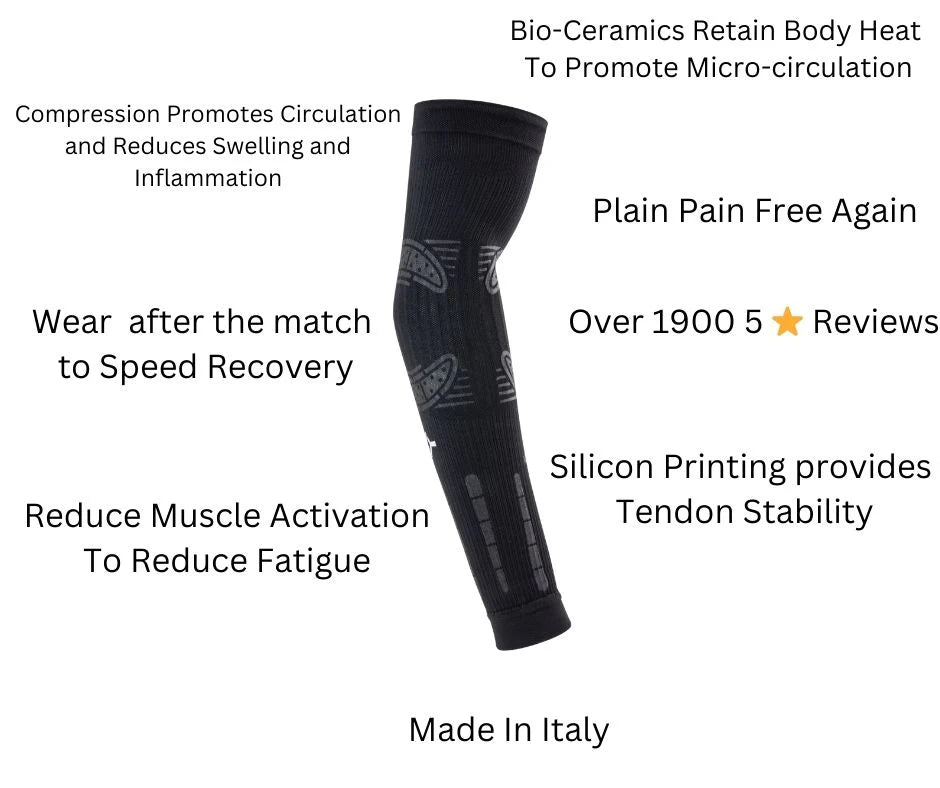When Not to Wear a Compression Sleeve
Medical Contraindications
(A Contraindication is a condition or circumstance that suggests or indicates that a particular technique or drug should not be used in the case in question - so these are medical signs or conditions that indicate you should not wear a compression sleeve!)
- Peripheral Arterial Disease: If you have suspected or proven peripheral arterial disease, including a history of peripheral arterial bypass grafting, you should avoid wearing compression sleeves[2].
- Severe Peripheral Neuropathy: Compression sleeves are contraindicated for those with severe peripheral neuropathy or other causes of sensory impairment[2].
- Ischemia: If you have a lack of oxygen in your limbs due to peripheral arterial disease, compression sleeves can worsen the condition[5].
- Open Wounds or Recent Skin Grafts: Compression sleeves should not be worn over open wounds, oozing dermatitis, or recent skin grafts[2][5].
Comfort and Fit Issues
- Pain or Discomfort: If you experience increased pain when wearing the sleeve, it's time to remove it and consult your healthcare provider[1][3].
- Ill-Fitting Sleeves: Compression sleeves that are too tight or too loose should not be worn, as they can be ineffective or potentially harmful[1].
- Skin Reactions: If you develop any skin irritation, redness, or allergic reactions to the sleeve material, discontinue use[2][5].
Specific Situations
- During Sleep: Generally, compression sleeves should not be worn while sleeping unless specifically instructed by a healthcare professional[4][10].
- When Wet: Avoid wearing compression sleeves during activities where they could become wet, such as swimming or bathing[3].
- Extended Periods of Inactivity: If you plan to be sedentary or reclining for a long time, it's best to remove the compression sleeve[10].
- Undiagnosed Pain: If you have undiagnosed knee or limb pain, consult a doctor before using compression sleeves[9].
Signs to Remove Immediately
- Neurological Symptoms: If you experience pins and needles, numbness, or altered sensation, remove the sleeve immediately[1].
- Increased Swelling: If you notice increased swelling, particularly in the hand when wearing an arm sleeve, take it off[1].
- Skin Discoloration: Remove the sleeve if you observe any unusual skin color changes, such as blueness in the fingers[3].
Remember, it's crucial to consult with a healthcare professional before using compression sleeves, especially if you have any pre-existing medical conditions or concerns about their use.
Citations:
[1] https://www.youtube.com/watch?v=8jBLNZRwrnE
[2] https://pmc.ncbi.nlm.nih.gov/articles/PMC4081237/
[3] https://healthsystem.osumc.edu/pteduc/docs/compression-sleeve.pdf
[4] https://www.bannerhealth.com/healthcareblog/better-me/how-a-compression-sleeve-could-help-your-sore-or-swollen-knee
[5] https://www.daylong.co.uk/info/compression-guides/contraindications/
[6] https://nufabrx.com/blogs/news/how-to-care-for-your-compression-sleeves-best-practices-for-maintenance-and-longevity
[7] https://bdrivensports.com/blogs/news/how-long-should-you-wear-a-compression-sleeve-a-comprehensive-guide
[8] https://www.thecompressionstockingcompany.com.au/pages/indications-contraindications
[9] https://incrediwear.com/blogs/news/compression-sleeves-may-hurt-rather-than-help
[10] https://nufabrx.com/blogs/news/how-long-can-you-wear-compression-sleeves


2 comments
Floky
Hi David! We’d recommend starting with a No Strain Sleeve – the compression should help with the inflammation that is leading to Golfer’s Elbow – the brace is designed for providing more support and structure, which you might not need. Hope this helps!
Hi David! We’d recommend starting with a No Strain Sleeve – the compression should help with the inflammation that is leading to Golfer’s Elbow – the brace is designed for providing more support and structure, which you might not need. Hope this helps!
David Peete
I have golfers elbow, and a little bit of a weak wrist. I am an intermediate level pickleball player.
Should i wear the extended arm brace or your elbow brace, or both, and when?
I have golfers elbow, and a little bit of a weak wrist. I am an intermediate level pickleball player.
Should i wear the extended arm brace or your elbow brace, or both, and when?